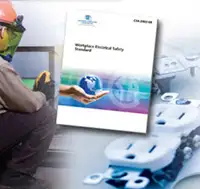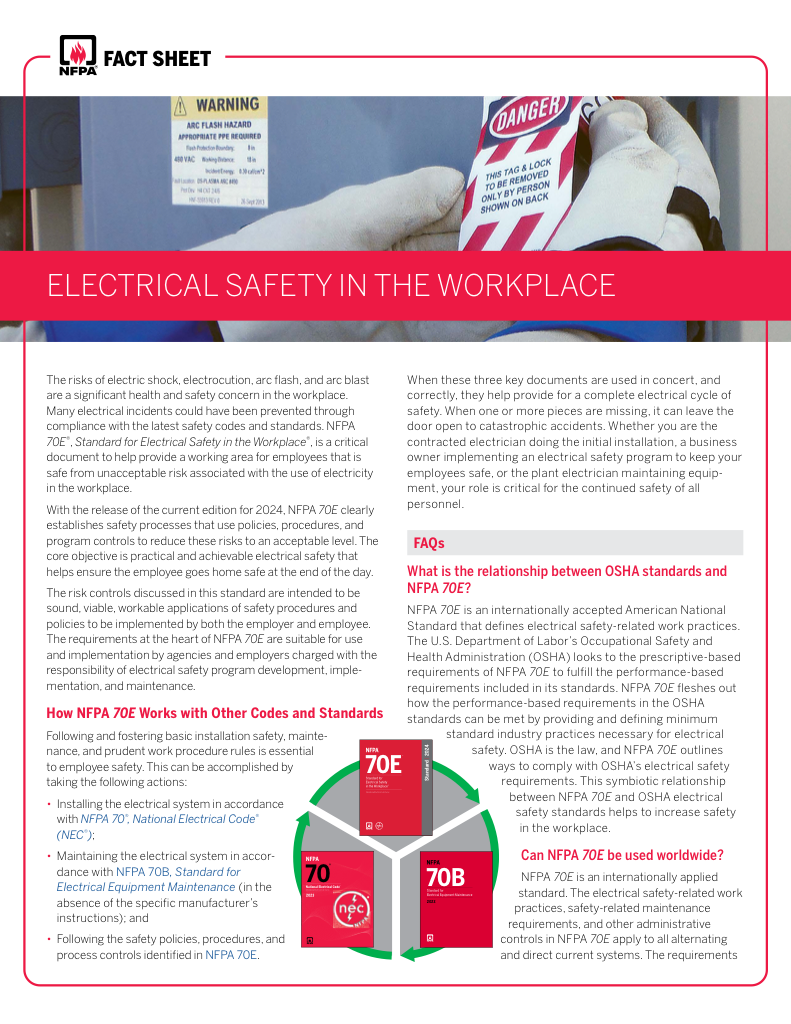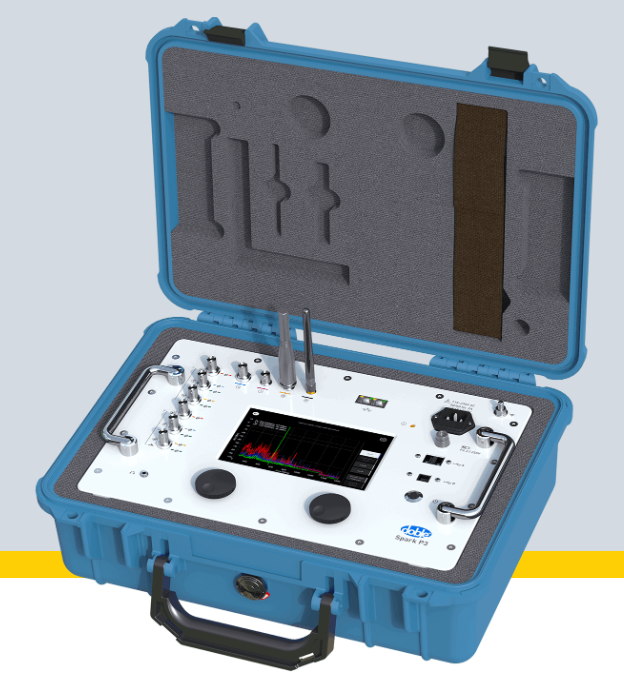CSA Z462 - Workplace Electrical Safety
By EF

NFPA 70e Training
Our customized live online or in‑person group training can be delivered to your staff at your location.

- Live Online
- 6 hours Instructor-led
- Group Training Available
Download Our NFPA 70E Fact Sheet – 2024 Electrical Safety Edition

- Understand how NFPA 70E works with NEC and NFPA 70B standards
- Clarify the shared responsibility between employers and employees
- Learn how NFPA 70E supports OSHA compliance
CSA Z462 is Canada's national standard for workplace electrical safety. It provides detailed arc flash and shock hazard protection requirements, including risk assessments, PPE guidelines, and safety training. Aligned with NFPA 70E, CSA Z462 helps employers create safer work environments and comply with regulatory expectations.
Visit Our CSA Z462 Arc Flash Training Course Page
What is CSA Z462?
The Canadian Standards Association's Workplace Electrical Safety Standard provides comprehensive guidelines for managing electrical hazards in the workplace, including arc flash and shock risks.
-
✅ Hazard Assessment: Outlines procedures for identifying electrical hazards and assessing risks associated with energized work.
-
✅ Personal Protective Equipment (PPE): Provides criteria for selecting appropriate PPE to protect workers from electrical hazards.
-
✅ Training Requirements: This section specifies the need for training programs to ensure workers are qualified to perform electrical tasks safely.
CSA Z462 incorporates essential principles found in related standards, including using a clearly defined arc flash boundary to protect workers from thermal injuries. An arc flash study based on incident energy analysis is required to determine safe work distances and PPE requirements. CSA Z462 mandates clear arc flash labels that communicate key hazard information as part of its labelling requirements. In addition to thermal protection zones, it also defines shock protection distances such as the limited approach boundary, helping organizations build a comprehensive electrical safety program.
CSA Z462 Workplace Electrical Safety Standard
This is the title given to Canada's Arc Flash Standard. Canadian electrical workers are exposed to many daily hazards during their work. Even so, until a few years ago, very few Canadian (i.e. Federal or Provincial) guidelines, Standards or Acts were published to assist employers and employees to more effectively manage the electrical safety hazards or even to determine who is qualified to perform electrical work tasks. Since 2006, CSA has been developing CSA Z462 - “Electrical Safety in the Workplace”
FREE EF Electrical Training Catalog
Download our FREE Electrical Training Catalog and explore a full range of expert-led electrical training courses.

- Live online and in-person courses available
- Real-time instruction with Q&A from industry experts
- Flexible scheduling for your convenience
CSA Z462 is based on NFPA 70E and was created to harmonize with the Canadian Electrical Code, CSA-Z460, Control of Hazardous Energy—Lockout and Other Methods, and CSA-M421, Use of Electricity in Mines.
This Standard was prepared by the CSA Technical Committee on Workplace Electrical Safety, under the Strategic Steering Committee on Occupational Health and Safety jurisdiction. It will be submitted to the Standards Council of Canada for approval as a National Standard of Canada.
CSA Z462 Arc Flash Standard
CSA Z462 specifies requirements for and provides guidance on safety management systems and safe work procedures for persons working on electrical equipment and electrical systems, and provides direction on selecting personal protective equipment and other safety devices for electrical workers and maintenance personnel. It also establishes criteria for identifying and training qualified electrical workers and for determining hazardous work to be performed only by those qualified individuals to improve electrically safe work conditions.
CSA Z462 Workplace Electrical Safety
CSA Z462 offers comprehensive guidance on workplace electrical safety, covering risk assessment, PPE requirements, lockout procedures, arc flash labeling, and updated safety definitions aligned with modern industry standards.
It includes detailed information on:
-
Lockout procedures and a new annex on hazardous energy control
-
Informational annexes to support implementation
-
Wearing protective clothing and PPE selection
-
Arc flash and shock hazard labeling requirements
-
Simplified 2-category PPE and clothing systems
-
Guidance on layering of PPE garments
-
Use of insulated tools and other protective equipment
-
Metrification of all measurement values
-
Risk assessment procedures and methods
-
New annex highlighting the use of recognized Occupational Health and Safety Management Standards
-
User-friendly methods for determining hazard risk categories based on defined tasks and arc flash levels
-
Complementary alignment with CSA Z460
-
Expanded and revised safety-related definitions
CSA Z462 vs NFPA 70E: How Workplace Electrical Safety Standards Align
CSA Z462 is the Canadian standard for workplace electrical safety. It offers a comprehensive framework for identifying and mitigating electrical hazards, including arc flash and shock. It is closely aligned with several other leading standards supporting a consistent, harmonized approach to electrical safety.
-
NFPA 70e (U.S. equivalent): CSA Z462 is modelled on NFPA 70e and shares its core principles. Both standards guide employers and workers in assessing arc flash and shock hazards, developing safe work practices, and selecting appropriate PPE to reduce injury risk during energized work.
-
IEEE 1584 – Arc Flash Hazard Calculations: CSA Z462 incorporates IEEE 1584 methodologies for calculating incident energy and determining arc flash boundaries. This ensures that arc flash risk assessments in Canada are technically consistent with globally accepted engineering practices.
-
ANSI Z535.4 – Safety Signage and Labels: While CSA Z462 outlines labelling requirements for arc flash and shock hazards, it also references ANSI Z535.4 for best practices in safety signage design, including symbols, signal words, and layout, helping ensure hazard communication is clear and standardized.
Together, these standards support a unified hazard identification system, worker protection, and regulatory compliance across North American workplaces.
Related Articles







